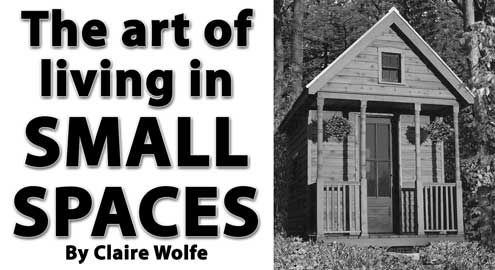Here is an exert from a great piece called “The art of living in a small space” It give some great advise and another view point

Long ago, I read that to live in the country you must have the soul of a poet, the dedication of a saint, and a good station wagon. Today I suppose you’d have to update the station wagon to an SUV, but the fact remains: To live successfully anywhere outside the mainstream of life you must have an unconventional spirit coupled with down-to-earth practicality—a combo that can be hard to find and harder still to balance. I live in the country, but my latest life choices have also involved living in miniature spaces—which presents an additional set of challenges, both to the soul and to practicality. For the last three years I’ve shared a one-room cabin with a pack of dogs and one outnumbered but boldly unflappable cat. The cabin has an exterior footprint of 409 square feet—nine feet above the minimum my county requires for a residence. Its interior space is about 360 square feet, including closets and cabinet space.
I work as well as live here, so I’m in this one room 24 hours a day, except when the critters and I are out dog walking, running errands, picking blackberries, or otherwise adventuring. On winter days, when I’m tripping over tails, wiping up muddy pawprints for the umpteenth time, and having accusatory canine noses stuck into my computer (“Mom, we’re booooored!”) the cabin sometimes feels as small as a shoebox. On summer afternoons, it’s luxuriously spacious with its glass door thrown open to sunlight and all its denizens sprawled on the deck. In fact it seems so large that I’m currently contemplating spending part of my year in a structure about one third this size. Think dollhouse (or rather, converted garden shed).
I’m hardly alone. Even as the size of the average new American house has more than doubled (from 1,100 square feet during the post-WWII housing boom to more than 2,225 by 1999), more and more people are also exploring small-space living. These include, most visibly, RVers spending months in their cleverly designed rolling homelets, simple-living advocates wanting to use fewer resources, homeless camper-dwellers, folks living on boats, and country newcomers (like many readers of this magazine) who are camping out in garages, trailers, cabins, or sheds while building their dream homes. Finally you’ve got people like me who’d rather have 409 paid-for square feet than 2,225 square feet of mortgaged luxury. RVers and boat dwellers have built-in advantages. Literally built-in. RVs and boats, with their endless crannies, hidden storage spaces, and double-purpose furnishings (like tables that turn into beds) provide the construction model for the rest of us. But there’s more to small-space living than just clever design. Living well in tiny spaces has four parts:
– Coping
– Building
– Gadgeting
– Decoratingd
Let’s take a brief look at all four. Oh, and before we do, I’ll confess that a lot of my knowledge comes from what I-didn’t-anticipate, or I-didn’t-do when I built my cabin. It was a learning experience.
This is just the intro, Read more of the Article here
I used to think I needed at least 750 square feet to live well. Now, I am in a home I plan to stay in for ten years. It is an RV that is 125 square feet, not counting the sleeping loft, cockpit, and exterior storage compartments. It is bright and spacious, and I have room in it for everything I need to live a full life but not enough room to clutter it up with things that don’t matter. I am at the end of a major renovating process to make the excellent floorplan even better for me and then I will start to decorate to suit my tastes. It turns out that it’s not the amount of space that matters but the quality of it and how it fits in with the life you want to lead.
I couldn’t agree more, today’s house that are huge lack true design. Most houses today are designed to be built for rapid deployment. When you have houses that are so big that being efficient and effective can be overcome by sheer volume, then any thought goes away.